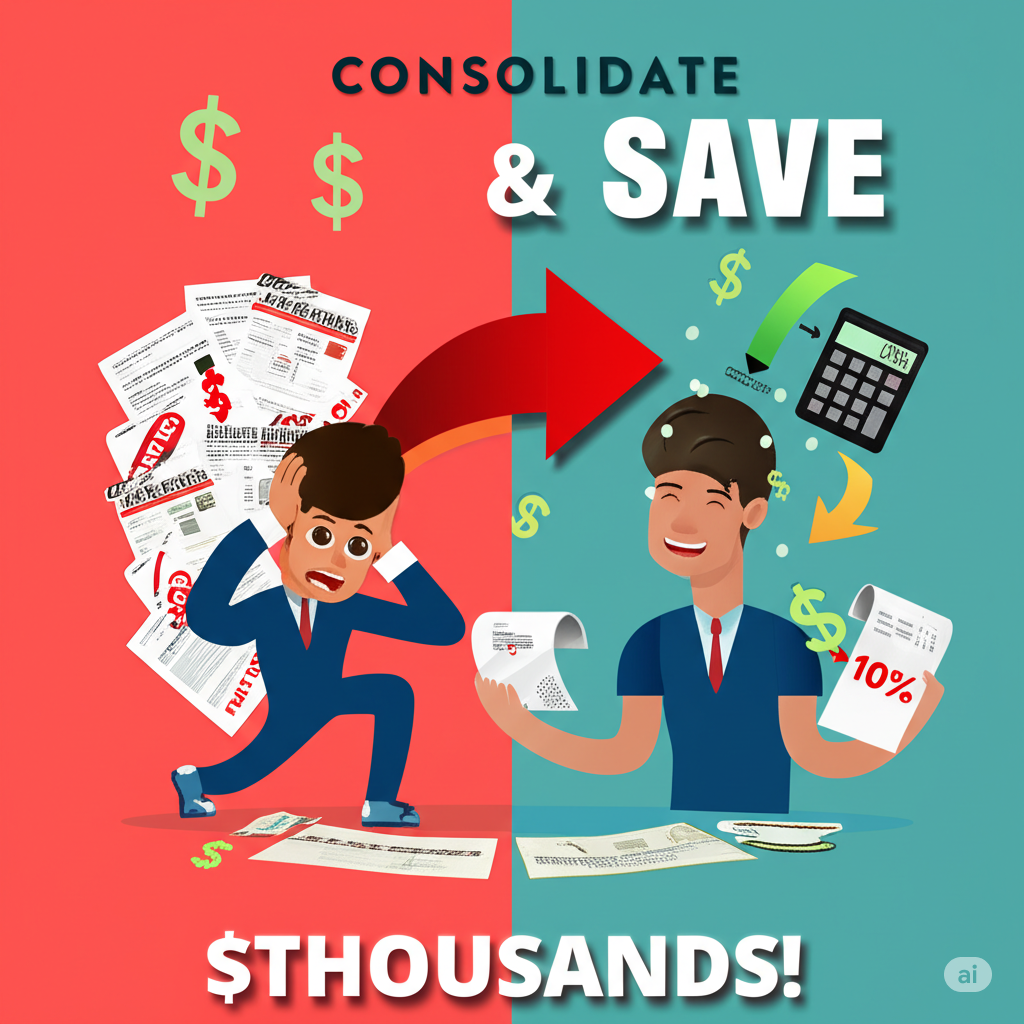Debt can feel like a constant weight on your shoulders, affecting everything from your sleep quality to your ability to plan for the future. If you’re among the millions of Americans struggling with overwhelming debt – you’re not alone.
The average U.S. household carries approximately $90,460 in debt, according to recent data from the Federal Reserve. The good news? Debt reduction programs have evolved dramatically in recent years, offering legitimate pathways to financial freedom that weren’t previously available to everyday consumers.
Whether you’re dealing with crushing credit card balances, medical bills that arrived at the worst possible time, or student loans that seem to grow despite your best efforts, understanding your debt reduction options can be the difference between years of financial stress and a clear path forward. In this comprehensive guide, we’ll explore the most effective debt reduction programs available today, how they actually work, and which one might be your ticket to financial freedom.
Table of Contents
What Are Debt Reduction Programs and How Do They Work?
Debt reduction programs are structured approaches designed to help individuals manage, reduce, and eventually eliminate their debt burden. Unlike temporary fixes that merely shuffle debt around, genuine debt reduction programs address the root issues and provide sustainable solutions.
Types of Debt Reduction Programs
| Program Name | How It Works | Best For | Additional Information |
|---|---|---|---|
| 1. Debt Consolidation Programs | Debt consolidation involves combining multiple debts into a single loan or payment plan, typically with a lower interest rate than your existing debts. You’ll work with a lender to secure a new loan large enough to pay off your existing debts. Once approved, the lender pays off your creditors directly, and you make one monthly payment to the new lender. | Individuals with good credit (typically 670+) who qualify for lower interest rates than they’re currently paying and have the discipline to avoid accumulating new debt. | Success rate: Approximately 70% of people who use debt consolidation successfully reduce their overall debt within 18 months, according to the National Foundation for Credit Counseling. |
| 2. Debt Management Plans (DMPs) | DMPs are structured repayment plans administered by credit counseling agencies. Credit counselors negotiate with your creditors to secure lower interest rates, waived fees, and affordable payment plans. You make one monthly payment to the counseling agency, which distributes the funds to your creditors. | People with manageable debt levels who need structure and support to make progress. | Statistical insight: DMPs have shown to reduce credit card interest rates from an average of 24.99% to 7.75%, potentially saving thousands in interest payments. |
| 3. Debt Settlement Programs | Debt settlement involves negotiating with creditors to accept less than the full amount owed to consider the debt satisfied. You or a settlement company negotiates with creditors to accept a lump-sum payment that’s less than your total debt. During negotiations, you typically stop making payments and instead save money for the settlement offers. | Individuals with significant financial hardship who cannot reasonably pay back their full debt amount within 5 years. | Important note: While settlements can reduce your debt by 30-50%, they significantly impact your credit score (typically dropping 80-110 points) and may have tax implications. |
| 4. Credit Counseling Services | Credit counseling provides education and personalized advice from certified counselors. After reviewing your finances, counselors help you develop a budget, suggest debt management strategies, and may recommend specific programs based on your situation. | Anyone struggling with debt who needs professional guidance to understand their options. | Accessibility factor: Many nonprofit credit counseling agencies offer free initial consultations, making this an excellent first step for most people. |
| 5. Debt Avalanche Method | The avalanche method is a debt reduction strategy focusing on high-interest debts first. You make minimum payments on all debts while directing extra money toward the debt with the highest interest rate. Once that debt is paid off, you redirect that payment amount to the next highest-interest debt. | Self-motivated individuals who want to minimize the total interest paid and can stick to a long-term plan. | Mathematical advantage: This approach saves the most money in interest compared to other self-directed strategies. |
| 6. Debt Snowball Method | The snowball method focuses on paying off smallest debts first for psychological momentum. Make minimum payments on all debts while directing extra money toward your smallest debt balance. After paying it off, redirect that payment to the next smallest debt. | People who need quick wins to stay motivated and committed to debt reduction. | Psychological benefit: Research from the Harvard Business Review suggests that the visible progress of the snowball method leads to higher completion rates compared to financially optimal approaches. |
| 7. Bankruptcy (Chapter 7 or Chapter 13) | Bankruptcy is a legal process that can eliminate or restructure certain debts. Chapter 7 liquidates non-exempt assets to pay creditors and discharges remaining eligible debts. Chapter 13 establishes a 3-5 year repayment plan for a portion of your debts. | Those with insurmountable debt and no viable alternative solutions. | Long-term impact: Bankruptcy remains on your credit report for 7-10 years but can provide a fresh start for those in severe financial distress. |
Choosing the Right Debt Reduction Program: 5 Essential Factors
Selecting the right program depends on your specific financial situation. Consider these critical factors:
1. Your Total Debt Amount and Types
Different programs work better for different debt types and amounts. Credit card debt often responds well to debt management plans, while overwhelming medical debt might be better addressed through settlement or bankruptcy.
Action step: Create a comprehensive list of all debts, including balances, interest rates, minimum payments, and debt types.
2. Your Credit Score and Financial Goals
Your current credit score and future financial goals significantly impact which program makes sense. Someone planning to buy a home in two years should avoid solutions that severely damage credit, like debt settlement.
Reality check: Debt management plans typically cause a minimal credit score impact, while debt settlement can drop scores by 80-110 points for up to seven years.
3. Monthly Income and Budget Flexibility
Successful debt reduction requires a sustainable approach aligned with your income reality.
Budget rule: A workable debt reduction plan should leave you with enough money for necessities and a small emergency fund contribution after making your debt payments.
4. Timeline for Debt Freedom
Consider how quickly you need or want to become debt-free. Some programs offer faster resolution but with greater credit impact.
Comparative insight: The average debt management plan takes 3-5 years to complete, while Chapter 7 bankruptcy can resolve in 4-6 months but with more severe consequences.
5. Emotional Relationship with Debt
Your psychological approach to debt management matters enormously.
Self-assessment question: Do you prefer the satisfaction of quick wins (debt snowball) or the mathematical efficiency of minimizing interest (debt avalanche)?
Real Stories: Debt Reduction Success
Sarah’s journey illustrates the power of choosing the right program. At 32, she found herself with $27,500 in credit card debt spread across six cards after a medical emergency and subsequent job loss.
“I was making minimum payments but watching my balances grow each month due to 24% interest rates,” Sarah explains. “After researching options, I worked with a nonprofit credit counseling agency to enroll in a debt management plan.”
The results were transformative. The agency negotiated her average interest rate down to 8%, reducing her monthly payment from $875 to $615. By maintaining consistent payments and avoiding new debt, Sarah became debt-free in 48 months, saving over $14,000 in interest compared to making minimum payments.
“The structure and support made all the difference,” she says. “Having one affordable monthly payment removed the overwhelming stress and gave me a clear path forward.”
Warning Signs: Red Flags in Debt Reduction Programs
While legitimate programs exist, the debt relief industry also attracts predatory companies. Watch for these warning signs:
- Upfront fees before any services are provided
- Guarantees about debt reduction amounts or timeframes
- Instructions to stop communicating with creditors
- Promises to remove accurate negative information from credit reports
- High-pressure sales tactics or rushing you to sign up
Protection step: Check any debt relief company with the Better Business Bureau and your state’s attorney general office before proceeding.
Beyond Programs: Complementary Strategies for Faster Debt Reduction
Successful debt reduction often combines formal programs with personal financial strategies:
- Income boosting: Consider temporary side gigs, selling unused items, or requesting overtime to accelerate debt payoff.
- Expense cutting: Identify non-essential expenses that can be temporarily reduced or eliminated. The average household can find $250-500 in monthly savings through careful budget examination.
- Interest rate negotiations: Contact creditors directly to request lower interest rates, especially if you have a good payment history.
- Balance transfer opportunities: For those with good credit, 0% APR balance transfer offers can provide 12-21 months of interest-free debt repayment.
- Automate minimum payments: Ensure you never miss payments by automating at least the minimum due on all accounts.
Conclusion: Your Path to Debt Freedom
Debt reduction isn’t just about numbers—it’s about reclaiming your financial future and peace of mind. The right program acts as a roadmap, providing structure, support, and a clear path forward.
Begin by honestly assessing your financial situation and researching programs that align with your specific needs. Remember that seeking help is a sign of financial responsibility, not failure. Many successful professionals, including financial advisors, have utilized debt reduction programs during challenging periods.
Take that crucial first step today by scheduling a free consultation with a nonprofit credit counseling agency. This no-obligation conversation can help clarify your options and set you on the path to financial freedom.
The journey to becoming debt-free may seem daunting now, but thousands before you have successfully traveled this road. With the right program and commitment, you can join them in experiencing the life-changing freedom that comes with breaking free from debt’s heavy burden.


